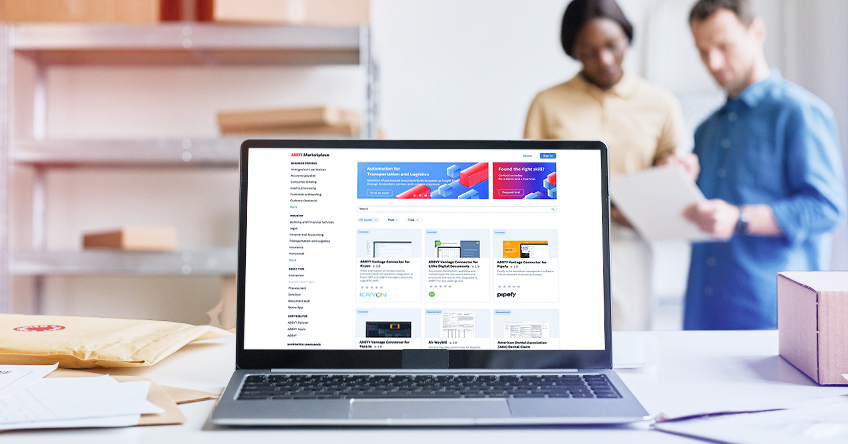
Streamlining Logistics with Advanced Supply Chain Robotics and Optical Character Recognition

Streamlining Logistics with Advanced Supply Chain Robotics and Optical Character Recognition
Clearing the Document Bottlenecks in Your Supply Chain Operations with a “Skills” Approach
Reginald J. Twigg
November 18, 2021

Supply chains are the lifeline of consumers and industries alike, and they are especially vulnerable to disruptions. We’ve all experienced the impact of disruption, especially in the past two years, but disruption is compounded with fierce competition—forcing tight schedules and thin margins. Supply chains run on documents at every point in their processes, from sourcing to shipping to customs clearances and payments, and the ability to handle documents directly impacts a company’s resilience, adaptability, competitive position, and profits.
Yet the approaches to handling documents is antiquated, often relying on legacy optical character recognition (OCR) procedures enhanced with robotic process automation (RPA) workarounds. What if there was a better way?
Overcome unstructured content as an obstacle to automation in logistics.
Start with understanding documents
Documents are containers of vital information to any supply chain operation. Sourcing and onboarding suppliers, for example, requires the exchange of packets of documents ranging from Supplier Agreements, Letters of Credit, Proofs of Identity and ability to pay, Certifications, and more. Shipments require Bills of Lading , Sea or Air Waybills , Customs Declarations, Invoices including Commercial Invoices , Tax, and Dangerous Goods Declarations in some cases. It is fair to say that documents are both the facilitators of supply chain actions and serve a vital vetting function throughout the process.

All too often, technology providers and companies are quick to reduce documents to data problems for systems of record, and this set of assumptions creates its own vulnerabilities to disruption and competition. Instead, documents contain both valuable data and content—the latter requiring skilled reading and context-grounded interpretation to make quick decisions. Skilled workforces interact with documents and content for this express purpose, since data only provides part of the picture needed to make critical decisions that move shipments or source materials and services every day. Artificial intelligence (AI) can add the dimension of skilled reading to documents, filling in that missing link between experience and data, but supply chains have yet to realize its potential for transforming their operations.
Add document ‘skills’ to your operations
If a skilled, trained, and experienced workforce were not required, the “document problem” would have been solved a decade ago, but the reality is that these skills and experience are needed frequently to make decisions on content—decisions on sourcing, shipping, and receiving. Data extraction is sufficient in most cases, and straight-through processing of documents at 90 percent or better has become a common expectation. But even that level of efficiency requires some built-in Intelligent Document Processing capabilities in the tools, and the rest requires advanced decision-making skills.
Having the right tools with experienced, human-like skills built in with new-generation AI and machine learning (ML) is the way to achieve higher processing accuracy and the exception handling and decision-making needed in normal activity and disruption. Containerized pre-trained “document skills” offer the right approach to handle both the volume and complexity of supply chain documents.
No longer do you need big capture platforms or frameworks to get the operational benefits of document skills. With the help of AI with pre-trained containerized document “skills” (pre-trained actions that understand the document, not just the data, but the actions needed to be taken on it), supply chains can finally remove common bottlenecks and gain control of the document-driven processes that all levels of business operations rely on—Transport & Logistics to Accounts Payable (AP) payment processing.
Want to optimize your Transportation & Logistics operations for rapid change?
We have a skill for that.
A marketplace approach
Speed is the key to customer satisfaction and competitive advantage in Transportation & Logistics . That is precisely the idea behind the new ABBYY Marketplace , the first digital marketplace for processing and understanding enterprise documents that provides a rich collection of content skills, connectors, and assets. Many of the top shippers and logistics providers, and many cloud-based companies, are providing their business users and citizen developers the best-in-class document and content processing with our easy-to-use, configurable, and pluggable platform, which is ready to use within minutes.
Learn more about how ABBYY ishelping Transportation and Logistics providers in supply chains become more nimble through the power of low-code / no-code in ABBYY Vantage and Marketplace—preloaded with skills developed by ABBYY and by our partners to automate all types of content-centric processes. With over 30 years of making document processing work for enterprises, ABBYY puts that experience to work in Vantage as the most complete and modern solution to Intelligent Document Processing.
Digital Transformation Intelligent Document Processing (IDP) Transportation & Logistics Robotic Process Automation (RPA)

Reginald J. Twigg
Like, share or repost
Share
Subscribe for blog updates
First name*
E-mail*
Сountry*
СountryAfghanistanAland IslandsAlbaniaAlgeriaAmerican SamoaAndorraAngolaAnguillaAntarcticaAntigua and BarbudaArgentinaArmeniaArubaAustraliaAustriaAzerbaijanBahamasBahrainBangladeshBarbadosBelgiumBelizeBeninBermudaBhutanBoliviaBonaire, Sint Eustatius and SabaBosnia and HerzegovinaBotswanaBouvet IslandBrazilBritish Indian Ocean TerritoryBritish Virgin IslandsBrunei DarussalamBulgariaBurkina FasoBurundiCambodiaCameroonCanadaCape VerdeCayman IslandsCentral African RepublicChadChileChinaChristmas IslandCocos (Keeling) IslandsColombiaComorosCongo (Brazzaville)Congo, (Kinshasa)Cook IslandsCosta RicaCroatiaCuraçaoCyprusCzech RepublicCôte d’IvoireDenmarkDjiboutiDominicaDominican RepublicEcuadorEgyptEl SalvadorEquatorial GuineaEritreaEstoniaEthiopiaFalkland Islands (Malvinas)Faroe IslandsFijiFinlandFranceFrench GuianaFrench PolynesiaFrench Southern TerritoriesGabonGambiaGeorgiaGermanyGhanaGibraltarGreeceGreenlandGrenadaGuadeloupeGuamGuatemalaGuernseyGuineaGuinea-BissauGuyanaHaitiHeard and Mcdonald IslandsHoly See (Vatican City State)HondurasHong Kong, SAR ChinaHungaryIcelandIndiaIndonesiaIraqIrelandIsle of ManIsraelITJamaicaJapanJerseyJordanKazakhstanKenyaKiribatiKorea (South)KuwaitKyrgyzstanLao PDRLatviaLebanonLesothoLiberiaLibyaLiechtensteinLithuaniaLuxembourgMacao, SAR ChinaMacedonia, Republic ofMadagascarMalawiMalaysiaMaldivesMaliMaltaMarshall IslandsMartiniqueMauritaniaMauritiusMayotteMexicoMicronesia, Federated States ofMoldovaMonacoMongoliaMontenegroMontserratMoroccoMozambiqueMyanmarNamibiaNauruNepalNetherlandsNetherlands AntillesNew CaledoniaNew ZealandNicaraguaNigerNigeriaNiueNorfolk IslandNorthern Mariana IslandsNorwayOmanPakistanPalauPalestinian TerritoryPanamaPapua New GuineaParaguayPeruPhilippinesPitcairnPolandPortugalPuerto RicoQatarRomaniaRwandaRéunionSaint HelenaSaint Kitts and NevisSaint LuciaSaint Pierre and MiquelonSaint Vincent and GrenadinesSaint-BarthélemySaint-Martin (French part)SamoaSan MarinoSao Tome and PrincipeSaudi ArabiaSenegalSerbiaSeychellesSierra LeoneSingaporeSint Maarten (Dutch part)SlovakiaSloveniaSolomon IslandsSouth AfricaSouth Georgia and the South Sandwich IslandsSouth SudanSpainSri LankaSurinameSvalbard and Jan Mayen IslandsSwazilandSwedenSwitzerlandTaiwan, Republic of ChinaTajikistanTanzania, United Republic ofThailandTimor-LesteTogoTokelauTongaTrinidad and TobagoTunisiaTurkeyTurks and Caicos IslandsTuvaluUgandaUkraineUnited Arab EmiratesUnited KingdomUnited States of AmericaUruguayUS Minor Outlying IslandsUzbekistanVanuatuVenezuela (Bolivarian Republic)Viet NamVirgin Islands, USWallis and Futuna IslandsWestern SaharaZambiaZimbabwe
I have read and agree with the Privacy policy and the Cookie policy .
I agree to receive email updates from ABBYY Solutions Ltd. such as news related to ABBYY Solutions Ltd. products and technologies, invitations to events and webinars, and information about whitepapers and content related to ABBYY Solutions Ltd. products and services.
I am aware that my consent could be revoked at any time by clicking the unsubscribe link inside any email received from ABBYY Solutions Ltd. or via ABBYY Data Subject Access Rights Form .
Referrer
Last name
Query string
Product Interest Temp
UTM Campaign Name
UTM Medium
UTM Source
ITM Source
GA Client ID
UTM Content
GDPR Consent Note
Captcha Score
Page URL
Connect with us
Also read:
- [New] The Ace Guide to Smooth Laptop Video Editing via Inshot
- [Updated] 2024 Approved The 10 Best Drones for Industrial Lifting Tasks
- [Updated] In 2024, Top Mac Speech-to-Text Apps You're Not Aware Of
- [Updated] Structuring Stimulating Podcast Segments
- [Updated] The Visionary's Manual Selecting the Most Compelling 4K Displays Today
- 1. Quick & Simple Guide: Transferring Your Data - Laptop to OneDrive with Just 3 Methods!
- Data Rescue Made Simple with Stellar UI on Mac
- Five Methods for Protecting Your PC: Avoiding BitLocker
- In 2024, Top 10 iPhone Lens Capabilities in iOS 11
- Unveiling the Finest Zero-Cost Digital Darkroom Tools for 2024
- Title: Streamlining Logistics with Advanced Supply Chain Robotics and Optical Character Recognition
- Author: Mark
- Created at : 2024-12-30 01:01:08
- Updated at : 2025-01-02 17:50:28
- Link: https://some-guidance.techidaily.com/streamlining-logistics-with-advanced-supply-chain-robotics-and-optical-character-recognition/
- License: This work is licensed under CC BY-NC-SA 4.0.